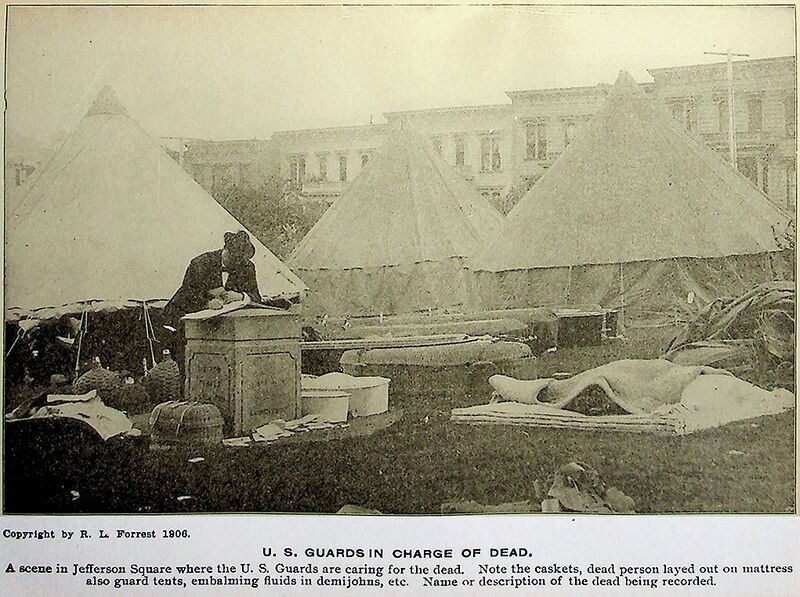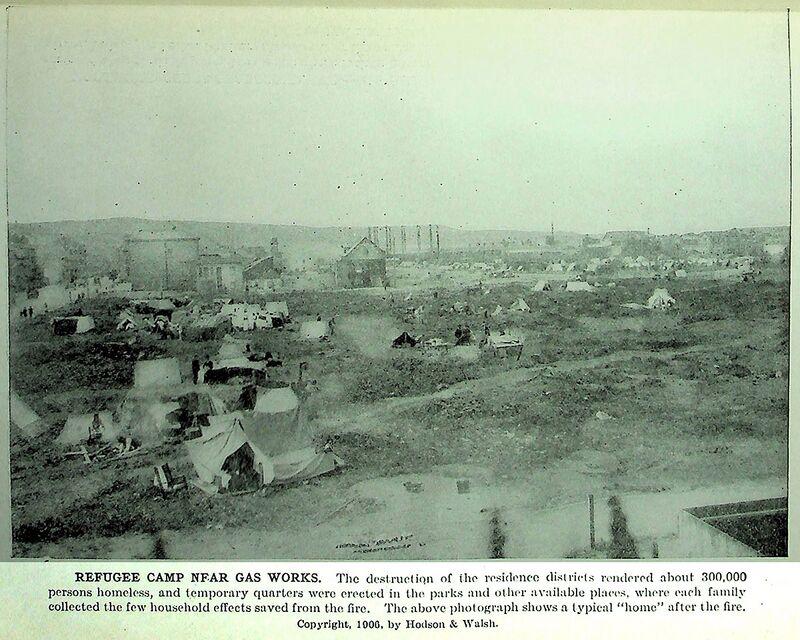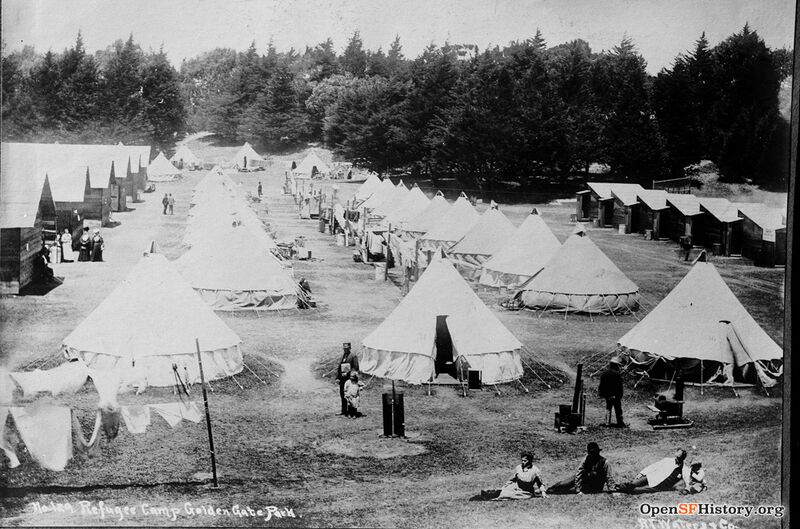Refugee Camps 1906: The First Month
Primary Source
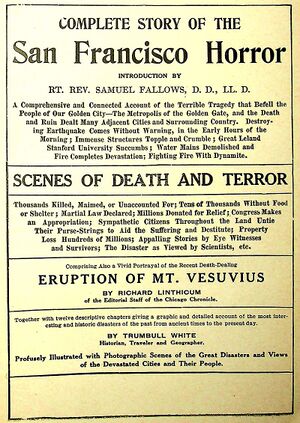
Originally published as Chapter 13, "In the Refugee Camps," in Complete Story of the San Francisco Horror" © 1906 by Hubert D. Russell
Scenes of Destitution in the Parks Where the Homeless Were Gathered—Rich and Poor Share Food and Bed Alike—All Distinctions of Wealth and Social Position Wiped Out by the Great Calamity.
NEXT to viewing the many square miles of ruins that once made San Francisco a city, no better realization of the ruin can be gained than from the refugee camps located in the districts which were untouched by the flames. Golden Gate Park was the mecca of the destitute. This immense playground of the municipality was converted into a vast mushroom city that bore striking resemblance to the fleeting towns located on the border of a government reservation about to be opened to public settlement.
The common destitution and suffering wiped out all social, financial and racial distinctions. The man who before the fire had been a prosperous merchant occupied with his family a little plot of ground that adjoined the open-air home of a laborer. The white man of California forgot his antipathy to the Asiatic race and maintained friendly relations with his new Chinese and Japanese neighbors.
Jefferson Square refugee camp, May 1906.
The society belle of the night before the fire, a butterfly of fashion at the grand opera performance, assisted some factory girl in the preparation of humble daily meals. Money had little value. The family who had foresight to lay in the largest stock of foodstuffs on the first day of the disaster was rated highest in the scale of wealth.
A few of the families who could secure willing expressmen possessed cooking stoves, but over 95 percent of the refugees had to do their cooking on little camp fires made of brick or stone.
Kitchen utensils that a week before would have been regarded with contempt were articles of high value.
Many of the homeless people were in possession of comfortable clothing and bed covering. The grass was their bed and their daily clothing their only protection against the penetrating fog of the ocean or the chilling dew of the morning. Fresh meat disappeared the first day of the catastrophe and canned foods and breadstuffs were the only victuals in evidence.
Not alone were the parks the places of refuge. Every large vacant lot in the safe zone was preempted and even the cemeteries were crowded.
A well-known young lady of social position when asked where she had spent the night replied: "On a grave."
Throughout the entire western portion of the peninsular county of San Francisco these camps were located.
Major McKeever of the United States Army was appointed commandant of the camps and, with his staff of assistants, brought system and order out of the chaotic situation. His first thought was to supply food and water and then to arrange sanitary measures. The throngs of people who crowded elbow to elbow in the open lots and fields without conveniences that are naturally demanded were constantly threatened with an epidemic of disease.
Refugee camp near gasworks close to today's Fort Mason and the edge of the Marina District.
Good order and fellowship prevailed in these impromptu settlements and the common ruin and poverty made all of the unfortunates akin.
In buildings close to the camps the police stored available foodstuffs and bed clothing for convenient delivery. No distinctions were drawn and but few favors shown in the distribution of supplies.
Although efforts of the various relief committees were bent to appease the gnawing hunger of the destitute thousands—efforts that were in a large measure entirely successful—there were many persons without sufficient food or entirely without it.
The government officials took charge of every grocery store in that part of the city still standing and gave out foodstuffs to all those who were hungry. Broad lines were established at Fillmore and Turk streets, at Golden Gate Park and at the Presidio and every person who stood in line was given a whole loaf. The line at Fillmore and Turk streets was four blocks long all one afternoon and those at the parks were even longer. A large supply of milk was received from Oakland in the morning and this was distributed to women and children whenever they were found in need. A great deal of this milk was used for the exhausted women.
The breadlines at the parks furnished striking instances of the absolute patience and fortitude that has marked the behavior of the people throughout their trying experience. There were no disorders when the hungry thousands were told to form a line and receive their bread and canned goods. All were content to wait their turn. Silk-hatted men followed good naturedly behind Chinese and took their loaves from the same hand.
Soup kitchens were established in the streets of the unburned section, no fires whatever being allowed indoors, and many hungry persons were fed by these individual efforts.
At the ferry station there were some pathetic scenes among the hungry people. When the boat came in from Stockton with tons of supplies a number of small children were the first to spy a large box of sandwiches with cries of delight. They made a rush for the food, seized as much as they could hold and rushed to the mothers with shouts of “Oh, mamma, mamma, look at the sandwiches!”
Seated around the Ferry Building sat hundreds of people sucking canned fruits from the tins. Some were drinking condensed cream and some were lucky enough to have sardines or cheese. At several places along Market Street scores of men were digging with their hands among the still smoking debris of some large grocery house for canned goods. When they secured it, which they did without molestation from anybody, they broke the tins and drank the contents.
At Filbert and Van Ness Avenue at 6 o'clock at night a wagon of supplies conveyed by soldiers was besieged by a crowd of hungry people. They appealed to the soldiers for food and their appeals were quickly heeded. Seizing an ax, a soldier smashed the boxes and tossed the supplies to the crowd, which took time to cheer lustily.
Owing to the energetic efforts of General Funston and the officials of the Spring Valley Water Company the sufferers in all parts of the city were spared at least the horrors of a water famine. As soon as it was learned that some few mercenaries who were fortunate enough to have fresh water stored in tanks in manufacturing districts were selling it at 50 cents per glass the authorities took prompt action and hastened their efforts to repair the mains that had been damaged by the earthquake shocks.
The work of relief was started early on the second day of the disaster. A big bakery in the saved district started its fires and 50,000 loaves were baked before night. The police and military were present in force and each person was allowed only one loaf.
The destitution and suffering were indescribable. Women and children who had comfortable, happy homes a few days before slept—if sleep came at all—on hay on the wharves, on the sand lots near North Beach, some of them under the little tents made of sheeting which poorly protected them from the chilling ocean winds. The people in the parks were better provided in the matter of shelter, for they left their homes better prepared.
Instructions were issued by Mayor Schmitz to break open every store containing provisions and to distribute them to the thousands under police supervision.
At one time bread sold as high as $1 aloaf and water at fifty cents a glass, but the authorities at once put a stop to the extortion.
Among the many pathetic incidents of the fire in San Francisco was that of a woman who sat at the foot of Van Ness Avenue on the hot sands on the hillside overlooking the bay east of Fort Mason with four little children, the youngest a girl of three, the eldest a boy of ten.
They were destitute of water, food and money. The woman had fled with her children from a home in flames in the Mission street district and tramped to the bay in the hope of sighting the ship, which she said was about due, of which her husband was the captain.
"He would know me anywhere," she said. And she would not move, although a young fellow gallantly offered his tent back on a vacant lot in which to shelter her children.
Among the refugees who found themselves stranded were John Singleton, a Los Angeles millionaire, his wife and her sister. The Singletons were staying at the Palace Hotel when the earthquake shock occurred on Wednesday morning.
Mr. Singleton gave the following account of his experience:
“The shock wrecked the rooms in which we were sleeping. We managed to get our clothes on and get out immediately. We had been at the hotel only two days and left probably $3,000 worth of personal effects in the room.
“After leaving the Palace we secured an express wagon for $25 to take us to the Casino near Golden Gate Park, where we stayed the first night. On the following morning we managed to get a conveyance at enormous cost and spent the entire day in getting to the Palace. We paid $1 apiece for eggs and $2 for a loaf of bread. On these and a little ham we had to be satisfied.”
Mr. Singleton, like thousands of other people, found himself without funds and he had difficulty in securing cash until he met someone who knew him.
To allay the fears of the refugees in the various camps Mayor Schmitz issued the following proclamation which citizens were instructed to observe:
“Do not be afraid of famine. There will be abundance of food supplied. Do not use any water except for drinking and cooking purposes. Do not light fires in houses, stoves or fireplaces. Do not use any house closets under any circumstances, but dig earth closets in yards or vacant lots, using if possible chloride of lime or some other disinfectant. This is of the greatest importance, as the water supply is only sufficient for drinking and cooking. Do not allow any garbage to remain on the premises; bury it and cover immediately. Pestilence can only be avoided by complying with these regulations. "You are particularly requested not to enter any business house or dwelling except your own, as you may be mistaken for one of the looters and shot on sight, as the orders are not to arrest but shoot down anyone caught stealing."
The refugees numbered all told about 300,000. At least 75,000 of them made their way to Oakland, Berkeley, Alameda, Benicia and neighboring cities while many more fortunate and prosperous succeeded in reaching Los Angeles.
The work of caring for the homeless in the refugee camps was splendidly managed under the direction of the citizens’ committee, the military authorities and the Red Cross.
The people were fed in a thoroughly businesslike and systematic manner. From the waterfront, where the boatloads of provisions docked, there was an endless procession of carts and drays carrying food to the scores of substations established throughout the city and the parks. At these stations food and drink, comprising bread, prepared meats and canned goods, milk and a limited amount of hot coffee, were served to all those who applied. About 1,500 tons of provisions were moved daily from the waterfront.
Large supplies of blankets, tentings and other material to provide coverage for those who were scantily supplied theretofore reached the supply stations rapidly. Barracks were erected at several points and in those many people have found comfort and shelter against the inclemency’s of the weather.
Informal 1906 refugee camp near Children's Playground in Golden Gate Park.
Photo: OpenSFHistory.org wnp26.1971
The situation in the congested districts such as Golden Gate Park and the various public squares throughout the city, was considerably relieved by the departure of many people for points on the other side of the bay, as soon as access was had to the Ferry Building. The exodus continued daily from the time the fire broke out until everyone who wished to get away had departed.
The greatest hardship experienced by the homeless refugees was on the first Sunday night following the fire.
From midnight Sunday until 3 o'clock Monday morning a drenching rain fell at intervals, while a high wind added a melancholy accompaniment, whistling and sighing about the ruins of the buildings in the burned district. Five days before when the fire catastrophe was in its infancy this downpour would have been regarded as a mercy and a godsend.
When it came it could be regarded in no other light than as an additional calamity. It meant indescribable suffering to the tens of thousands of people camped upon the naked hills and in the parks and open places of the city.
Few of them were provided with waterproof covering. For the most part their only protection from the wet was a thin covering of sheeting tacked upon improvised tent-poles. Through this the water poured as through a sieve, wetting the bedding and soaking the ground upon which they lay.
When it is understood that thousands upon thousands of delicately nurtured, women and infants in arms and old and feeble people were m this plight nothing need be added to describe the misery of their condition.
What could be done was done by the guards in charge of the camps to relieve the distress. Whenever covering could be had for the women and children it was taken advantage of. They were housed in the chill and cheerless churches, garages and barns, and those who had been fortunate enough to save their homes were called upon to take care of these unfortunates. With few exceptions these people responded readily to the new call made upon them and where they did not the butt-ends of Krag rifles quickly forced a way through inhospitable doors.
Of individual instances of suffering the whole number is legion, but one will tell the story of them all.
About 4 o'clock, when the rain had been falling heavily for an hour, a middle-aged man, white-faced in his distress and fatigue, appeared at the headquarters of the general committee. He had walked two miles from his camping place in the park to make an appeal for his suffering wife and little ones. As he told of their distress the tears welled up in his eyes and coursed down his cheeks.
They were, he said, without covering other than a sheeting overhead and were lying on the naked ground and their bodies protected only by a quilt and blanket, which of his household bedding were all he had managed to save. These had quickly been soaked, and while unwilling to complain on his own account he had been unable to listen to the wails of his little ones and had tramped all the way from his camping place to the committee headquarters in the forlorn hope that there he might find some means of getting his family under shelter.
The condition of the 5,000 people or more camped in Jefferson Square Park was something terrible. Not more than 5 per cent had even an army tent and the makeshifts were constructed of carpets, bedsheets and every imaginable substance. They were totally inadequate to keep out the heavy rain.
Probably Camp 5 at Big Rec in Golden Gate Park.
Photo: OpenSFhistory.org wnp26.1955
The 400 soldiers of the Fifth and Sixth California National Guard were requisitioning. Glenn A. Durston of the Spanish War Veteran's relief committee, had charge of the relief work.
The spirit and courage shown by the sufferers in the face of their misfortunes was wonderful. An aged, crippled woman lying on the dirt floor of patchwork, bedsheets, carpets and tin roofing made a remark which was a sample.
"I am the widow of a union soldier," she said. "The sufferings related by my husband at Vicksburg were as nothing compared to mine. I am very comfortable, thank you.”
Many temporary emergency hospitals were established in and near the refugee camps. The St. Paul Lutheran church near Jefferson Square was one, but the big hospital at the Presidio, the military headquarters of the government, provided for the greater number of crises.
A temporary detention hospital was also established in the basement of the Sacred Heart school, conducted by the Dominican Sisters at the corner of Fillmore and Hayes streets, and the first commitment since the earthquake was made on the Sunday following the fire. The sisters of the Sacred Heart kindly turned over a part of the already crowded quarters to the insanity commissioners, and a number of patients made insane by the fire were cared for there.
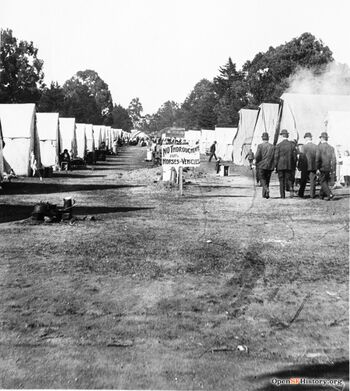
Refugee Camp No. 7 in the vicinity of Sharon Meadow in Golden Gate Park.
Photo: OpenSFhistory.org wnp37.01538
At the General Hospital the wards were soon full of patients, but few were suffering from severe types of sickness. There were many cases of tonsilitis, colds and such ills.
Within a week after the fire thousands of people left the refugee camps and found homes with friends in nearby places. One week after the disaster the authorities estimated that the number of campers on the grounds had been reduced to less than 8,000, where over 30,000 people had camped.
Temporary structures were erected in Golden Gate Park for the housing of 40,000 people, who had been sleeping out of doors for nearly a week and they were moved into comfortable quarters. About the same time a supply of blankets and bedding was received.
Within a week from the beginning of the disaster the refugee camps were converted into comfortable places of residence, with adequate sanitation, and the homeless at least had temporary homes. All this was accomplished with a minimum of suffering and illness that speaks volumes for the courage, energy and common sense of the American people.

